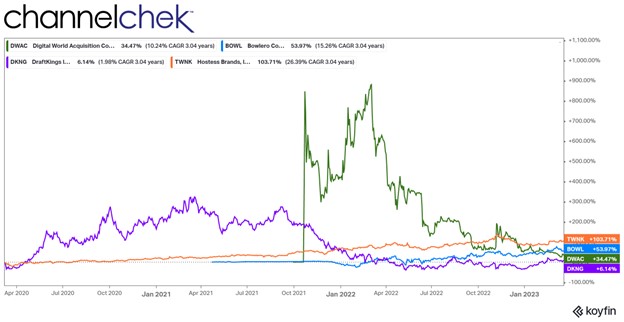
Less Attention is Being Paid to SPACs, But the Risk Reward Scenario Can’t Be Ignored
Uncertain markets warrant additional attention to risk versus possible reward on investments, especially when the least risky money funds pay 4% or more. This need to minimize risk, yet desire to have the opportunity to, at a minimum, beat inflation and in the best case scenario, hit a grand slam, might cause investors to revisit the hot investment of 2021. Like most investment sectors that do well, back then it became too crowded with issuance and overpromise. But the Special Purpose Acquisition Corp (SPAC), is getting far less attention these days – yet the relatively low risk for investors, and low competition for acquisition corps. to find that “unicorn,” it could increase the percentage of SPAC home runs. All the while limiting potential downside returns.
Special Purpose Acquisition Corps.
Investors that just want to make (or lose) the returns of a major index may not find investing in individual SPACs, at any stage, fits their investment approach. But the SPAC legal structure could suit investors that want to minimize their downside to a more or less known potential, and maximize their possible above average returns – SPACs may match these investment objectives better than alternatives.
Let’s cover risk first. SPAC investors have limited risk as their investment is held in a trust account until the SPAC identifies a target company and completes a merger. If the SPAC fails to identify a target, the investors will return their money, plus today’s higher accrued interest rates, less management, legal, and administrative fees. That is to say, a SPAC purchased as an IPO could be expected to be up or down one or two percent from the initial (usually $10) IPO price.
As ulcer-producing volatility in the major indices over the past year has shown, the feeling of having a floor on losses is comforting. The monetary distance to this floor is reduced if a post SPAC IPO, still looking for a target is trading below the $10 IPO price.
Does low risk mean low returns? SPACs offer the potential for low risk/high returns for investors who get in before an announced target. If the SPAC is successful in identifying and merging with a high-growth company, the share price could increase significantly. The targets often are successful private companies with tremendous potential, more of the potential could be realized with an injection of cash from the SPAC merger/acquisition. that would be able to expand.
What if an investor is opposed to the proposed merger? SPAC investors have the flexibility to decide whether or not to participate in the merger with the target company. If they choose not to participate, they can redeem their shares for the original investment amount plus interest, less administrative costs. This is another way that investors minimize their downside risk.
What are the risks? Investing in SPACs also comes with potential risks, such as the possibility of the SPAC failing to identify a suitable target company, this would essentially have tied up the investment capital used to purchase the SPAC. Another risk is the target company not performing as expected after the merger; as mentioned above, the pre-merger investor gets to decide if they opt in or opt to have pro-rata share of initial investment returned. As with any investment, it’s important to do your due diligence, look at any changes in the regulatory environment, and carefully evaluate the structure and goals.
What Does SPAC Investment Success Look Like?
Not all SPACs find a suitable target. An investor wants the management team exploring possibilities to be diligent and picky. But despite the large number of SPACs that have gone no place during the abundance offered in 2021, it’s easy to find examples of why investors like the market. Below are three very different examples of what success looks like:

In green is Digital World Acquisition Corp. (DWAC). It’s the only stock represented below that is pre-merger. The initial IPO was for $10 back in April 2021. Recent numbers show that a failure to merge with its current target, Trump Media, would result in approximately a $10 per share liquidation. Initial investors will have lost opportunity should this occur as they took the full ride from beginning to this possible end.
In October after the IPO, Digital World announced it had reached a preliminary agreement to merge with the digital media company founded by the former U.S. president. The shares skyrocketed over 900%. For those that bought the once $10 shares for $96, they may not have called this right, for those that purchased around the offer price, their risk of losing money is low, and they currently sit at a 34% profit.
In orange is Hostess (TWNK). This has been a SPAC success story which dates back to 2016 when there were only 13 SPAC IPOs all year. By comparison, there were 613 in 2021, and to date only 8 in 2023. Fewer SPACs chasing the same potential targets could work in investors’ favor. Many of the SPACs that are still less than two year old are still shopping. However most of those arrangements are expected to be returning shareholder funds. While Hostess is up 103% since March three years ago, it has gained 236% since the merger announcement.
Bowlero (BOWL), shown in blue, announced the merger with Isos Acquisition Corp. on July 1, 2021. The merged company would have at first disappointed investors as it dipped slightly. This is understandable as investing in leisure did not seem that it would offer quick gratification, as the pandemic hit this sector hard. However, the stock is up 54% in less than two years and up 58% YTD.
Shown here in purple, DraftKings (DKNG) merged April 24, 2020. Post merger, for those who held the Diamond Eagle Acquisition SPAC shares, they saw the stock jump 5% on the day of the announcement, eventually rise over 350%, and over time come back down to match the initial jump, 6% YTD.
Above are success stories, of varying degrees. There are many SPACs that don’t find the ideal merger partner, for the initial purchasers at $10, or those buying shares sub-$10 after the offering, their risk can be considered lower than the overall market. The potential for large gains, exists.
What Does a SPAC Investment Failure Look Like?
The most an investor will lose in an index fund investment approximates the decline of the index less management fees. The most an investor in any of the individual stocks in a major market index can lose is all of their investment. When an investor takes part in a SPAC IPO or purchases shares trading below the IPO price later, they have claim to funds held in escrow that would have been used for an acquisition. These funds seldom grow or shrink by more than 2%. SPAC investors could look at the risk of losing $2 per share (2%), versus possibly gaining double or triple-digit returns as better than market risk. But investors have lost some of their initial investment, and once the deal is struck, voted on by shareholders, and moves forward, the investment risk goes from very low, to just as risky as any other company traded. In other words, up to 100%.
Take Away
Low-risk and high-reward investments may not suit all portfolios. But for those that like to reduce the odds of loss, the glut of previously offered SPACs that are retiring this year, coupled with the lack of new offerings, could set the stage for easier target hunting for unmatched SPACs. Also, older SPACs trading at or below the enterprise value may be worth looking at, the cash in the escrow accounts are earning today’s yields, and may even be worth more than the share price.
To look for current opportunities of companies that have announced a merger, but not yet completed one, a source of information is Channelchek. Earlier this month, Better World Acquisition Corp. (BWAC) announced it will be merging with Heritage Distilling Co. The combined company expects to trade under the ticker CASK. A current research report detailing the planned acquisition along with valuation is made available here, from Noble Capital Markets.
Managing Editor, Channelchek
Sources
https://www.spacanalytics.com/
https://www.chase.com/personal/investments/learning-and-insights/article/what-is-a-spac